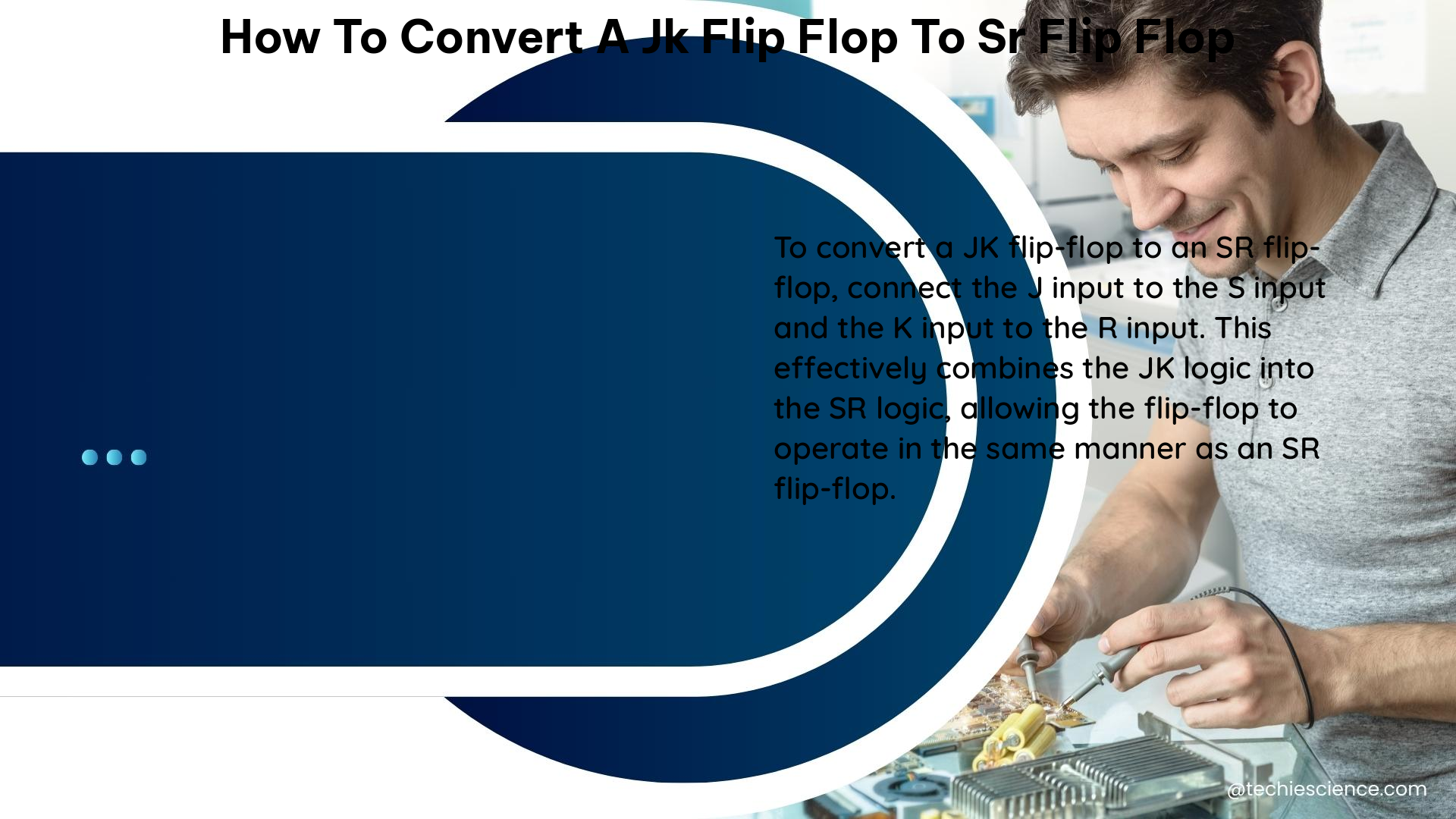Summary
Converting a JK flip-flop to an SR flip-flop is a straightforward process that involves connecting the S input to the J input and the R input to the K input. This conversion can be done without the need for additional circuitry or manipulation of connections. The excitation table of the JK flip-flop can be used to find the required J and K inputs for each output transition of the SR flip-flop.
Understanding the JK Flip-Flop and SR Flip-Flop

The JK flip-flop is a more versatile version of the SR flip-flop, as it can be used to implement all the basic flip-flop functions, including the SR, D, and T flip-flops. The JK flip-flop has two inputs, J and K, and two outputs, Q and Q’.
The truth table for the SR flip-flop is as follows:
| S | R | Q(t+1) |
|---|---|---|
| 0 | 0 | Q(t) |
| 0 | 1 | 0 |
| 1 | 0 | 1 |
| 1 | 1 | Indeterminate |
The excitation table for the JK flip-flop is as follows:
| J | K | Q(t+1) |
|---|---|---|
| 0 | 0 | Q(t) |
| 0 | 1 | 0 |
| 1 | 0 | 1 |
| 1 | 1 | ~Q(t) |
Conversion Process
To convert a JK flip-flop to an SR flip-flop, you need to connect the S input to the J input and the R input to the K input. This is because the JK flip-flop can behave as an SR flip-flop without the need for additional circuitry or manipulation of connections.
The process can be summarized as follows:
- Connect the S input to the J input.
- Connect the R input to the K input.
By doing this, the JK flip-flop will now function as an SR flip-flop, with the following behavior:
- When both S and R inputs are 0, the flip-flop retains its current state.
- When S is 0 and R is 1, the flip-flop resets to 0.
- When S is 1 and R is 0, the flip-flop sets to 1.
- When both inputs are 1, the output of the flip-flop is indeterminate.
Excitation Table Mapping
The excitation table of the JK flip-flop can be used to find the required J and K inputs for each output transition of the SR flip-flop. By mapping the JK excitation table to the SR truth table, we can determine the appropriate J and K inputs.
| SR Transition | JK Inputs |
|---|---|
| 0 0 (Retain) | J = 0, K = X |
| 0 1 (Reset) | J = X, K = 1 |
| 1 0 (Set) | J = 1, K = X |
| 1 1 (Indeterminate) | J = X, K = 0 |
Here, “X” represents a “don’t care” condition, meaning the input can be either 0 or 1 without affecting the output.
Deriving the J and K Expressions
By solving the K-maps for the J and K inputs, we can get the expressions for the J and K in terms of the S and R inputs. The expression for the K is equal to R, and the expression for the J is equal to S.
Therefore, the final expressions are:
- K = R
- J = S
Practical Implementation
To practically implement the conversion of a JK flip-flop to an SR flip-flop, you can follow these steps:
- Identify the JK flip-flop circuit or module in your design.
- Locate the J and K inputs of the JK flip-flop.
- Connect the S input to the J input.
- Connect the R input to the K input.
- Ensure that the clock and other control signals are properly connected.
- Verify the functionality of the converted SR flip-flop by testing it with different input combinations.
Remember to consider the timing constraints, propagation delays, and other design factors when implementing the conversion in a real-world circuit or system.
Conclusion
Converting a JK flip-flop to an SR flip-flop is a straightforward process that involves connecting the S input to the J input and the R input to the K input. This conversion can be done without the need for additional circuitry or manipulation of connections. By using the excitation table of the JK flip-flop, you can determine the required J and K inputs for each output transition of the SR flip-flop. The final expressions for the J and K inputs are J = S and K = R, respectively.
This conversion technique is useful when you need to replace a JK flip-flop with an SR flip-flop in your circuit design or when you want to simplify the implementation of an SR flip-flop using a JK flip-flop.
Reference:
- GeeksforGeeks, “Conversion of J-K Flip-Flop into D Flip-Flop”, 2020-04-22, https://www.geeksforgeeks.org/conversion-of-j-k-flip-flop-into-d-flip-flop/
- Electronics Tutorials, “Conversion of Flip-flops”, https://www.electronics-tutorials.ws/sequential/conversion-of-flip-flops.html
- All About Circuits, “Conversion of JK Flip-Flops”, 2016-08-10, https://www.allaboutcircuits.com/technical-articles/conversion-of-flip-flops-part-iii/
- YouTube, “JK to SR Flip Flop, JK to D Flip-Flop and JK to T Flip-Flop Conversion”, 2022-08-20, https://www.youtube.com/watch?v=bl77FRTAXWA

The lambdageeks.com Core SME Team is a group of experienced subject matter experts from diverse scientific and technical fields including Physics, Chemistry, Technology,Electronics & Electrical Engineering, Automotive, Mechanical Engineering. Our team collaborates to create high-quality, well-researched articles on a wide range of science and technology topics for the lambdageeks.com website.
All Our Senior SME are having more than 7 Years of experience in the respective fields . They are either Working Industry Professionals or assocaited With different Universities. Refer Our Authors Page to get to know About our Core SMEs.